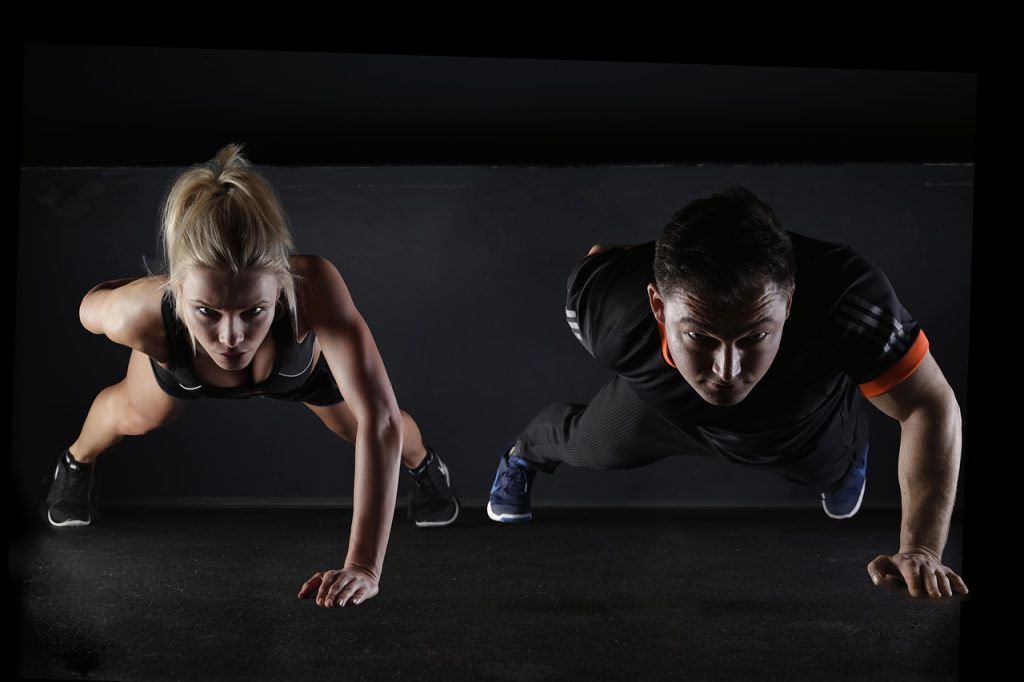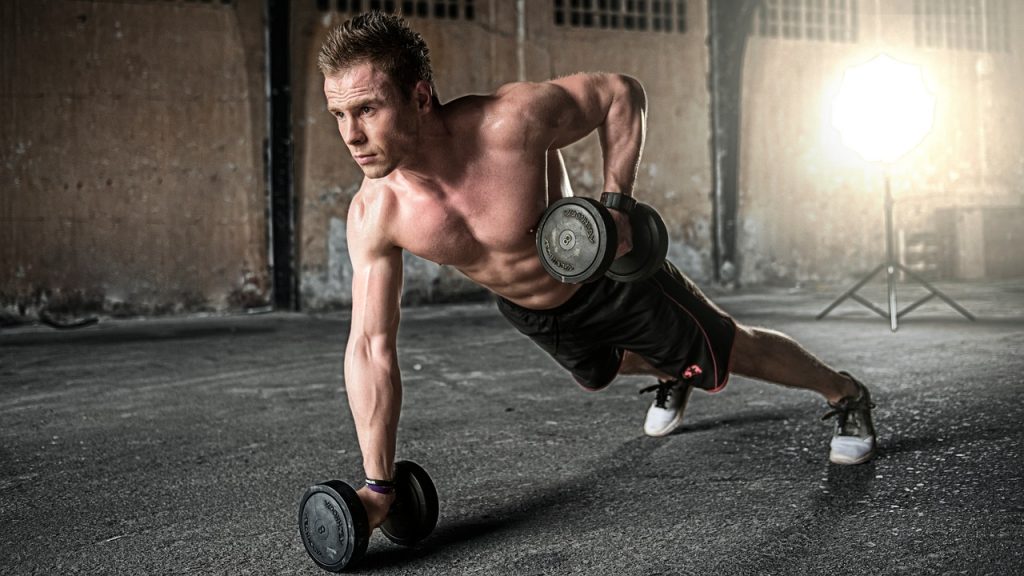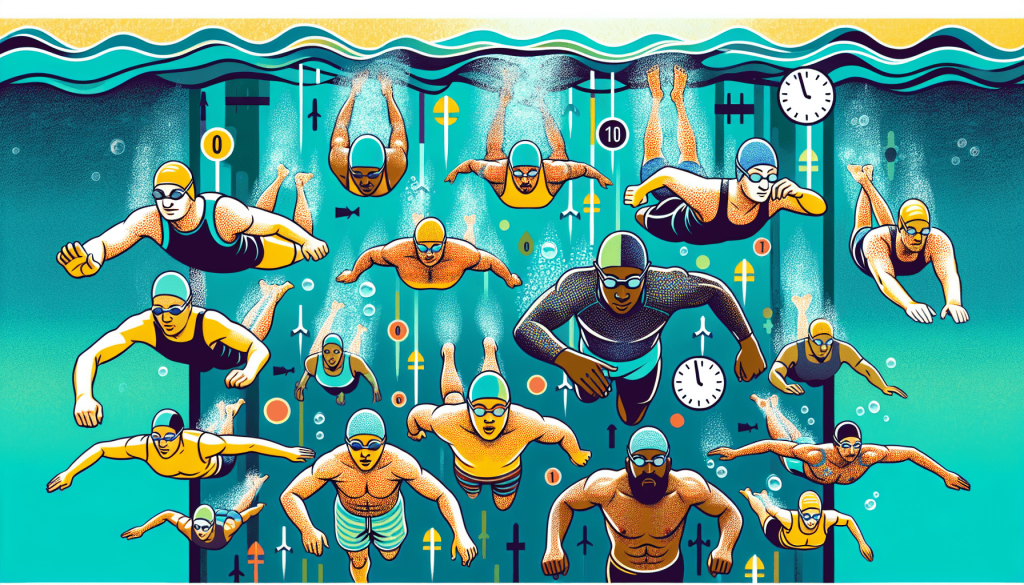Imagine being able to achieve your dream of having a six-pack while doing something fun and refreshing like swimming. This article explores the possibility of swimming as a method to develop those coveted abdominal muscles. Many people wonder if swimming alone can contribute to the development of a six-pack, and this article aims to provide answers to this frequently asked question. So, dive into the world of swimming and discover if it can truly help you achieve those toned abs you’ve always desired.
Benefits of Swimming for Six-Pack Abs
Engages Core Muscles
Swimming is a full-body workout that engages and strengthens your core muscles, including your abdominal muscles. As you move through the water, your core muscles work to stabilize your body and maintain proper form. This constant engagement of your core helps to strengthen and tone your abdominal muscles, ultimately contributing to the development of a six-pack.
Increases Abdominal Strength
Swimming regularly can significantly increase the strength of your abdominal muscles. The resistance provided by the water forces your core muscles to work harder than they would on land, leading to increased muscle strength and definition. By consistently challenging your abs in the water, you can expect to see improvements in your core strength and the appearance of your six-pack.
Improves Posture
Good posture is essential for not only a healthy spine but also for showcasing your six-pack. Swimming, with its emphasis on proper body alignment and correct breathing techniques, can help improve your posture. As you swim, you are constantly engaging your core muscles to maintain stability, which in turn promotes proper posture both in and out of the water. By strengthening your core and improving your posture through swimming, you can enhance the visibility of your six-pack.
Burns Calories and Fat
One of the major benefits of swimming for six-pack abs is its ability to burn calories and fat. Swimming is a highly effective cardiovascular exercise that gets your heart rate up and boosts your metabolism. This means that you can burn a significant amount of calories and fat during your swim sessions, helping you achieve a lower body fat percentage and uncover those abdominal muscles. By incorporating swimming into your fitness routine, you can torch calories and reduce fat, ultimately revealing the six-pack you’ve been working hard for.
Swimming Techniques for Six-Pack Abs
Freestyle Stroke
The freestyle stroke, also known as the front crawl, is a highly effective swimming technique to develop six-pack abs. It engages your entire body, particularly your core muscles, as you alternate between kicking your legs and pulling your arms through the water. The continuous motion of the freestyle stroke provides a great cardiovascular workout while simultaneously working your abdominal muscles. By mastering this technique, you can maximize the benefits of swimming for your six-pack.
Kickboard Exercises
Using a kickboard during your swim workouts is an excellent way to specifically target your core muscles and build six-pack abs. By holding onto the kickboard and focusing on kicking your legs, you can isolate your abdominal muscles and work them to exhaustion. This form of resistance training in the water not only strengthens your core but also enhances your overall swimming technique. Incorporate kickboard exercises into your swim sessions for a more intense core workout and optimal abdominal muscle development.
Butterfly Stroke
The butterfly stroke is often regarded as one of the most challenging swimming techniques, but it is also highly effective for sculpting six-pack abs. This stroke requires powerful and coordinated movements of your arms, legs, and core muscles to propel yourself through the water. The explosive butterfly kick, combined with the undulating motion of your body, places a significant demand on your abdominal muscles. By including the butterfly stroke in your swimming routine, you can strengthen your core and work towards a more defined six-pack.
Breaststroke
The breaststroke is another swimming technique that can contribute to the development of six-pack abs. It involves a whip-like kick, an arm pull, and a glide phase, all of which engage your core muscles. The undulating motion of the breaststroke requires your abs to work continuously, leading to increased abdominal strength and muscle definition. Incorporating the breaststroke into your swim workouts can provide variety and target different areas of your core, further enhancing your six-pack development.

Complementary Exercises for Six-Pack Abs
Plank Variations
Planks are a staple exercise for strengthening your core and developing six-pack abs, and they can be an excellent addition to your swimming routine. There are various plank variations you can perform to target different regions of your abs. Some examples include the standard plank, side plank, and plank with leg lifts. By incorporating these plank exercises into your fitness regimen, you can further challenge your core muscles and enhance their development.
Russian Twists
Russian twists are an effective exercise for targeting your obliques, the muscles on the sides of your abdomen. To perform this exercise, sit on the floor with your knees bent, lean back slightly, and lift your feet off the ground. Hold a weight or medicine ball with both hands and rotate your torso from side to side. This twisting motion engages your obliques and helps to define the sides of your six-pack. Incorporate Russian twists into your workout routine to strengthen your obliques and create a more well-rounded six-pack.
Leg Raises
Leg raises are a fantastic exercise for targeting your lower abdominal muscles. To perform this exercise, lie flat on your back with your legs extended. Slowly lift your legs off the ground, keeping them straight, until they are perpendicular to the floor. Lower your legs back down in a controlled manner, engaging your abs throughout the movement. Leg raises effectively work your lower abs, helping you achieve a more complete six-pack. Include leg raises in your core workout routine for a stronger and more defined lower abdominal region.
Crunches
Crunches are a traditional abdominal exercise that can be performed on land to complement your swimming routine. Lie on your back with your knees bent and your feet flat on the ground. Place your hands behind your head or crossed on your chest and contract your abs to lift your upper body off the ground. Lower yourself back down in a controlled manner. Crunches target your rectus abdominis, the main muscle responsible for a six-pack appearance. Adding crunches to your workout routine can help strengthen and define your frontal abdominal muscles.
Importance of Proper Nutrition
Balanced Diet
To maximize the results of swimming for six-pack abs, it is crucial to follow a balanced diet. A balanced diet consists of incorporating a variety of nutrient-dense foods from different food groups. Focus on consuming lean proteins, such as chicken, fish, and tofu, to support muscle growth and repair. Incorporate plenty of fruits and vegetables to provide essential vitamins, minerals, and antioxidants. Whole grains and complex carbohydrates should also be included for sustained energy during your swimming workouts. Prioritize a balanced diet to fuel your body properly and promote muscular development.
Adequate Protein Intake
Protein plays a key role in the development and repair of muscles, making it essential for achieving six-pack abs. Consuming an adequate amount of protein is crucial, especially when engaging in a physically demanding activity like swimming. Include lean protein sources such as chicken breast, fish, lean beef, eggs, and plant-based proteins like lentils and quinoa in your meals. Aim for a protein intake of about 0.8-1 gram per pound of body weight to support muscle growth and recovery.
Hydration
Proper hydration is often overlooked but is essential for overall health and performance, including the development of six-pack abs. When swimming, your body loses water through sweat, so it is crucial to replenish those fluids to maintain optimal performance. Dehydration can lead to muscle cramps, decreased energy levels, and diminished swimming performance. Aim to drink water before, during, and after your swim sessions to stay adequately hydrated. If you are swimming for an extended period or in hot weather, consider using a sports drink to replenish electrolytes lost through sweat.

Swimming Frequency and Duration
Consistency is Key
Consistency is key when it comes to swimming for six-pack abs. To see significant results, it is important to maintain a consistent swimming routine. Aim to swim at least 3-4 times per week to allow your body enough time to adapt and progress. Consistency will help build up your endurance, increase muscle strength, and burn calories effectively. By making swimming a regular part of your fitness routine, you will increase your chances of developing a six-pack that you can be proud of.
Finding the Right Balance
While consistency is important, it is equally essential to find the right balance in terms of swimming frequency and duration. Pushing yourself too hard and swimming for hours on end can lead to overtraining and potential muscle strain or injury. Conversely, swimming too infrequently or for short durations may not provide enough stimulus for your muscles to develop and improve. Listen to your body, gradually increase the intensity and duration of your swimming sessions, and find a balance that allows for adequate recovery while still challenging your muscles.
Common Mistakes to Avoid
Overtraining
One common mistake people make when trying to develop a six-pack through swimming is overtraining. Overtraining occurs when you push your body beyond its limits without allowing adequate time for recovery. This can lead to injuries, muscle fatigue, and a decrease in performance. It is crucial to give your body sufficient time to rest and recover between swim sessions to prevent overtraining. Incorporate rest days into your training schedule and listen to your body’s signals to avoid pushing yourself too hard.
Lack of Variety
Swimming the same stroke or using the same swimming techniques repeatedly can lead to plateaus and limited progress. To continuously challenge your muscles and stimulate growth, incorporate a variety of swimming techniques into your routine. Switching between different strokes, drills, and kickboard exercises can target different muscle groups, prevent boredom, and facilitate overall muscle development. Embrace variety in your swim workouts to keep your muscles guessing and to optimize your six-pack results.
Poor Form
Maintaining proper form while swimming is essential to avoid unnecessary strain on your muscles and reduce the risk of injury. Poor form can also prevent you from effectively engaging and targeting your abdominal muscles. Make sure to work with a swimming coach or instructor to ensure that you are executing each swimming technique correctly. Proper form will allow you to maximize the benefits of swimming for your six-pack abs and minimize the risk of setbacks due to incorrect technique.

Tracking Progress and Setting Goals
Measuring Body Fat
One of the most effective ways to track your progress when developing a six-pack is by measuring your body fat percentage. Body fat percentage indicates the amount of fat relative to your total body weight. There are several methods to measure body fat, including skinfold calipers, bioelectrical impedance analysis, and DEXA scans. Regularly tracking your body fat percentage will provide a concrete measure of your progress and help you adjust your training and nutrition accordingly.
Setting Realistic Goals
Setting realistic goals is crucial to maintain motivation and prevent disappointment. Developing six-pack abs takes time and dedication, so it is essential to set achievable goals along the way. Start by setting small, short-term goals that are within reach, such as increasing the duration or intensity of your swim sessions. As you achieve these smaller goals, gradually set bigger ones that align with your long-term objective of developing a prominent six-pack. Celebrating each milestone along the way will help you stay motivated and enthusiastic about your progress.
Celebrating Milestones
When working towards developing a six-pack through swimming, it is important to celebrate milestones and acknowledge your achievements. Whether it’s reaching a certain body fat percentage, swimming a certain distance, or improving your swimming technique, every accomplishment should be recognized and celebrated. Rewarding yourself for your hard work and dedication will reinforce positive behavior and make the journey towards a six-pack more enjoyable.
Swimming Safety and Precautions
Warm-up and Cool-down
Prior to diving into your swim workouts, it is crucial to warm up your muscles and prepare your body for exercise. A warm-up consisting of light aerobic exercises, dynamic stretches, and mobility drills helps increase blood flow to your muscles, raises your body temperature, and reduces the risk of injury. Similarly, cooling down after a swim session with gentle stretches and low-intensity exercises allows your body to gradually return to its resting state and prevents muscle soreness. Prioritize warming up and cooling down to keep your body safe and primed for optimal performance.
Proper Breathing Techniques
Breathing is an essential aspect of swimming, and using proper breathing techniques can contribute to swimming efficiency and safety. Depending on the stroke you are practicing, you will need to coordinate your breathing with your arm and leg movements. For example, during freestyle, you should exhale through your nose or mouth when your face is in the water and take quick inhales when turning your head to the side. Learning and practicing proper breathing techniques not only improve your swimming performance but also ensure a safe and enjoyable swim.
Swimming in Safe Environment
Swimming in a safe environment is crucial to prevent accidents and ensure your well-being. Choose swimming pools that are well-maintained, clean, and properly supervised. Make sure the water is free from any potential hazards or contaminants that could compromise your safety. If swimming in open water, be aware of potential dangers such as strong currents, underwater obstacles, or hazardous weather conditions. Prioritize your safety by familiarizing yourself with the environment and swimming in designated areas with lifeguards present.
Being Aware of Limitations
Understanding and respecting your limitations is essential when swimming for six-pack abs. Pushing yourself too hard or attempting advanced swimming techniques beyond your current abilities can lead to injuries or accidents. Progress gradually, listen to your body, and know when to take breaks or seek professional guidance. Do not feel the need to compare yourself to others or feel discouraged if you are not progressing as quickly as you would like. Each individual’s journey is unique, and focusing on your own progress and safety is essential for long-term success.

Factors That Can Impact Results
Genetics and Body Composition
It is important to recognize that genetics and overall body composition play a role in the development and visibility of six-pack abs. Some individuals may naturally have a higher propensity to develop visible abdominal muscles, while others may have to work harder to achieve the same results. Additionally, body fat percentage plays a crucial role in revealing the underlying abdominal muscles. Even with consistent swimming and proper nutrition, certain individuals may require a lower body fat percentage to achieve a pronounced six-pack. Accepting and understanding these factors can help set realistic expectations and focus on personal progress rather than comparisons.
Diet and Lifestyle
While swimming is an effective tool for developing six-pack abs, it is just one piece of the puzzle. Your diet and lifestyle choices also play a significant role in achieving desired results. Consuming a healthy and balanced diet, managing overall caloric intake, and avoiding excessive consumption of processed foods and sugary beverages will support your journey towards a more defined six-pack. Additionally, getting sufficient sleep, managing stress levels, and incorporating other forms of exercise can contribute to better overall health and the visibility of your abdominal muscles.
Consistency in Training
Consistency in your swimming and fitness routine is vital for achieving sustainable results. Developing six-pack abs takes time, and progress may not happen overnight. Consistently committing to your swimming sessions, maintaining a balanced diet, and incorporating complementary exercises will help you reach your goals. Trust the process, stay committed, and understand that consistency is key when it comes to transforming your physique.
Conclusion
Swimming can be an effective way to develop a six-pack, but it should be complemented with proper nutrition and additional exercises. The benefits of swimming for six-pack abs include engaging core muscles, increasing abdominal strength, improving posture, and burning calories and fat. To optimize your swim workouts, focus on swimming techniques such as freestyle stroke, kickboard exercises, butterfly stroke, and breaststroke. Complementary exercises like planks, Russian twists, leg raises, and crunches can further enhance core strength and abdominal muscle development. Proper nutrition, including a balanced diet and adequate protein intake, is crucial for fueling your body and supporting muscle growth. It is important to maintain consistency in your swimming routine while finding the right balance with frequency and duration to avoid overtraining. Additionally, tracking progress, setting realistic goals, celebrating milestones, ensuring swimming safety, and considering factors like genetics and lifestyle choices will contribute to your success. Remember, developing a six-pack through swimming is a journey that requires patience, dedication, and a holistic approach. Stay focused, stay motivated, and enjoy the process of sculpting your abs in the pool.





